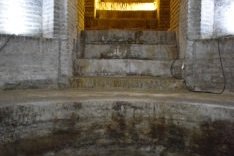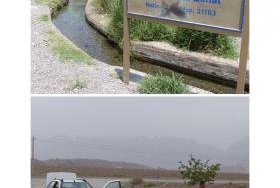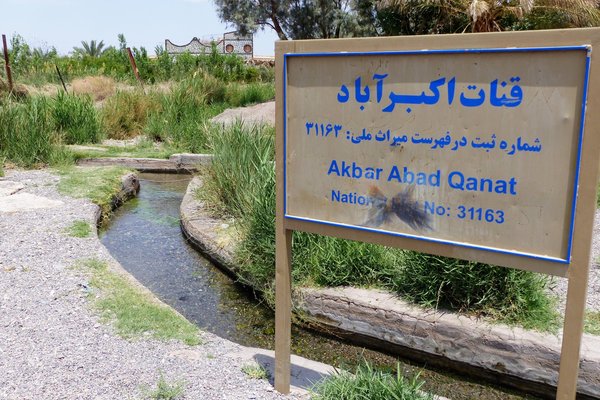Iran
The Persian Qanat
The Persian Qanat is an ancient underground water management system used for irrigation in a desert climate.
The system is communally managed. With the use of water clocks, a just and exact distribution among the shareholding farmers is ensured. Water is transported by mere gravity. The qanat system enabled the development of settlements and agriculture.
Community Perspective: The site comprises 11 qanats, and you’ll likely bump into one when visiting other WHS in Central and Eastern Iran. Solivagant explains “How to visit a Qanat”, while Bernard details his visit to the Zarch Qanat in Yazd.
Site Info
Official Information
- Full Name
- The Persian Qanat (ID: 1506)
- Country
- Iran
- Status
-
Inscribed 2016
Site history
History of The Persian Qanat
- 2016: Advisory Body overruled
- ICOMOS proposed Deferral
- 2016: Revision
- On T List as "Qanats of Gonabad"
- 2016: Inscribed
- Inscribed
- Type
- Cultural
- Criteria
- iii
- iv
Links
- UNESCO
- whc.unesco.org
- Official
-
- visitiran.ir — Visit Iran
All Links
UNESCO.org
- whc.unesco.org — whc.unesco.org/
Official Website
- visitiran.ir — Visit Iran
Community Information
- Community Category
- Secular structure: Civic and Public Works
Travel Information
Exact locations inscribed twice (or more)
Red Zone Travel Advisory
Isfahan Hotspot
Kerman Hotspot
Recent Connections
-
Marco Polo
While in Kerman, Iran (three qanats the… -
Red Zone Travel Advisory
Iran fully off-limits -
Untranslated Toponyms
"Qanāh (قناة) is an Arabic word that me…
Connections of The Persian Qanat
- Individual People
-
-
Marco Polo
While in Kerman, Iran (three qanats there are inscribed), he described them as a "river" connected to wells, visible from the surface. These underground channels are known as qanats and are a system for transporting water. Marco Polo's description of them is one of the earliest Western accounts of this unique irrigation system.
-
- Geography
-
-
Linear inscriptions
Most of the inscribed sites consist of linear areas 30m either side of the tunnel.
-
- Trivia
-
-
Subterranean Cultural Sites
A significant aspect of the Qanats OUV is the extent of the underground workings - including the longest Qaant in the world
-
- World Heritage Process
-
-
Extended from original TWHS
Only Gonabad qanat was originally proposed -
Exact locations inscribed twice (or more)
Parts of the Akbar Abad and Ghasam Abad Qanats in Bam are already inscribed under Bam CL. Also part of Persian Gardens: The Hasan-e Mashir qanat runs through the Pahlavanpur Garden in Mehrez near Yazd: "Hassan Abad-e Mashir, Yazd, dates from 1400CE and irrigates the Pahlavanpur and 5 other gardens" (AB ev)
-
- Human Activity
- Constructions
-
-
Tunnels
Qanats are constructed as a series of well-like vertical shafts, connected by gently sloping tunnels (wiki)
-
- Timeline
-
-
Built in the 4th century BC
Qasabeh, Khorasan-e Razavi/Gonabad, dates from 3- 4 centuries BCE (AB ev)
-
- WHS Hotspots
-
-
Isfahan Hotspot
3 of the qanats are within 125km of Isfahan -
Kerman Hotspot
Ghasem and Akbar Assad nr Bam
-
- Visiting conditions
-
-
Red Zone Travel Advisory
Iran fully off-limits
-
- WHS Names
-
-
Untranslated Toponyms
"Qanāh (قناة) is an Arabic word that means "channel". In Persian, the words for "qanat" are kārīz (or kārēz; كاريز) and is derived from earlier word kāhrēz (كاهریز) (But) the word qanāt (قنات) is also used in Persian.
-
News
No news.
Recent Visitors
Visitors of The Persian Qanat
- Afshin Iranpour
- Alexander Parsons
- Ammon Watkins
- Atila Ege
- AYB
- Bernard Joseph Esposo Guerrero
- Carlo Sarion
- Chalamphol Therakul
- David Marton
- DouglasR
- Erik Jelinek
- Eva Kisgyorgy
- Fan Yibo
- Fmaiolo@yahoo.com
- George Gdanski
- Hammeel
- Harald T.
- Ivan Rucek
- Jacob Otten
- Jarek Pokrzywnicki
- Javier
- Jean Lecaillon
- Jonas Kremer
- Joyce van Soest
- Kevin247
- Loic Pedras
- Maciej Gil
- Martina Rúčková
- MaYumin
- Nihal Ege
- Palimpsesto
- Reisedachs
- Roger Ourset
- Roman Bruehwiler
- Sergio Arjona
- Solivagant
- Ssong.x
- Stanislaw Warwas
- Szucs Tamas
- Taotao Chen
- Thomas Buechler
- Timothy C Easton
- Tony H.
- Westwards
- Wieland
- Wojciech Fedoruk
- Yongcheng Liu
- Zoë Sheng
Community Reviews
Show full reviews
This is probably the UNESCO World Heritage Site I spent the most time in trying to understand how to “properly” visit it during my recent trip in Iran. When I was just about to give up on it, a sign suddenly emerged in the streets of the historic city of Yazd referring to the “Zarch Qanat gallery”. This seems to be an improvement since the previous reviewer went to Yazd last year (exactly 12 months apart!), reporting the glaring lack of any public information about the qanats.
Later on, my friend and I realized that there were in fact a lot of signs all over showing some sort of a direction. Only to find out that — after intently and passionately following the signs for nearly an hour — it was not really leading us to a “gallery” (i.e., an exhibit, a museum, or a showroom)! Rather, it was just illustrating where the qanat flows underneath the city! This finding was interesting, but it was far from constituting a “proper” visit.
Much to my surprise later that day, however, we eventually got the proper visit that we needed no less than inside the Great Friday Mosque itself. At the main gate of the mosque, I already wondered why there was a banner congratulating “… the successful inscription of the Persian Qanats as a UNESCO World Heritage Site”. Sadly, it obviously and shamefully fails to indicate the more important detail – that a part of the qanat can actually be accessed …
Keep reading 0 comments
Before our Iran trip in Apr/May 2016 we had gained access via this Website to the “Executive Summary” for Iran’s nomination of “The Persian Qanat” (Its consideration by the 2016 WHC was of course still c2 months away). This document, which alone is 66 pages long, showed that the original T List definition for the “Qanats of Gonabad” had been significantly altered as per this Forum post.
But, even if the nomination were to be successful, we couldn’t of course be sure that all 11 nominated Qanats will get inscribed. So – which to visit? We decided to target the Qanats at Bam and Yazd.
But “how” does one actually visit a qanat?? Its very nature is as a narrow underground man-made water channel whose digging and maintenance is a dangerous job- all of which makes it unlikely “visit material”!!
The areas which were potentially to be inscribed encompass, for each Qanat
a. The “Mother Well”. This is usually deep underground since it accesses a source for the underground water. It is likely to be situated out in the country towards a mountainous area where some geological feature (sill or fault etc) has caused the underground run-off from the mountains to accumulate for “tapping”
b. The Course of the qanat – it appears that Iran has adopted the standard of nominating a 30m wide core area with the narrow tunnel underneath at its centre. This tunnel will descend very slowly gradually, getting closer to the surface along the course …
Keep reading 0 comments
